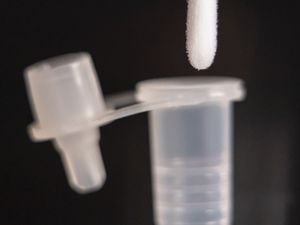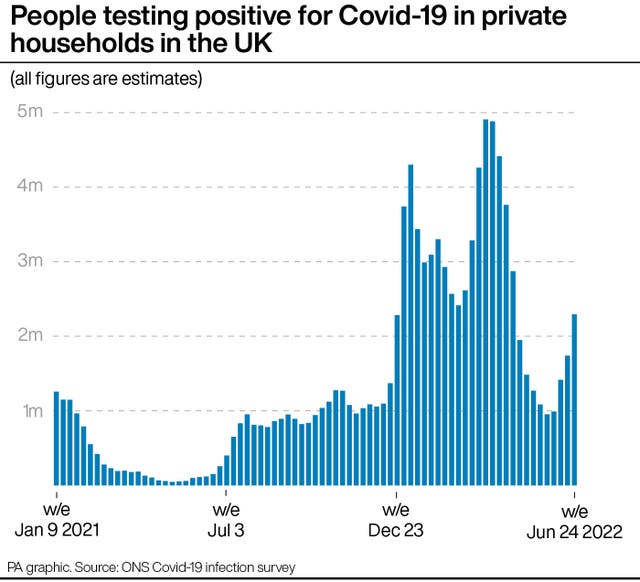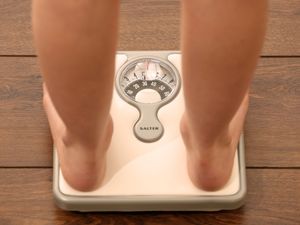Covid-19 infections in UK jump by more than half a million in a week
Total infections are now at levels last seen in late April.

Covid-19 infections in the UK have jumped by more than half a million in a week, with the rise likely to be driven by the latest Omicron variants BA.4 and BA.5, figures show.
Hospital numbers are also continuing to increase, with early signs of a rise in intensive care admissions among older age groups.
A total of 2.3 million people in private households are estimated to have had the virus last week, up 32% from a week earlier, according to the Office for National Statistics (ONS).
This is the highest estimate for total infections since late April, but is still some way below the record high of 4.9 million seen at the peak of the Omicron BA.2 wave at the end of March.

Sarah Crofts, ONS head of analytical outputs for the Covid-19 infection survey, said: “Across the UK we’ve seen a continued increase of over half a million infections, likely caused by the growth of BA.4 and BA.5 variants.
“This rise is seen across all ages, countries and regions of England.
“We will continue to monitor the data closely to see if this growth continues in the coming weeks.”
The virus remains most prevalent in Scotland, where 288,200 people were estimated to have had Covid-19 last week, or one in 18.
This is up week-on-week from 250,700, or one in 20, and is the highest estimate for Scotland since early April.
In England, 1.8 million people were likely to have had the virus last week, the equivalent of around one in 30.
This is up from 1.4 million, or one in 40, the previous week.
Wales has seen infections jump to 106,000, or one in 30, up from 68,500, or one in 45.
In Northern Ireland, infections have increased to an estimated 71,000 people, or one in 25, up from 59,900, or one in 30.
Prevalence of the virus in England is likely to be highest among 50 to 69-year-olds, where 4.2% – one in 25 – were likely to have had the virus last week.
The next highest estimate was for 25 to 34-year-olds, at 4.1%.
It is too soon to see any impact on infection numbers from recent large events such as the Glastonbury Festival, Wimbledon or the Hyde Park music festival.
But Friday’s figures are the latest evidence that the virus is circulating at increasing levels across the country.
Dr Mary Ramsay, director of clinical programmes at the UK Health Security Agency (UKHSA), said: “We continue to see an increase in Covid-19 data, with a rise in case rates and hospitalisations in those aged 65 years and over, and outbreaks in care homes.
“We can also now see a rise in ICU admissions in older age groups.
“Vaccination remains the best defence against severe disease and hospitalisation. Covid-19 has not gone away and we should all remember to keep up good hand and respiratory hygiene. It is also sensible to wear a face covering in crowded, enclosed spaces.”
Around one in six people aged 75 and over have not received a vaccine dose within the past six months, putting them more at risk of severe disease, the UKHSA added.
All over-75s in the UK have been offered a “spring booster”, available at least three months after their most recent jab, to ensure they continue to receive the maximum possible protection from the virus.
The total number of people in hospital who have tested positive for Covid-19 is now on a clear upwards trend in much of the UK.

Some 9,389 patients in England had Covid-19 as of July 1, up 39% on the previous week, Government figures show.
This is just over half the level of patients recorded at the peak of the Omicron BA.2 wave.
In Wales, 575 patients with Covid-19 were in hospital on June 30, up 53% from the previous week.
And Scotland has seen patients jump 34% week-on-week, reaching 1,298 on June 26.
The trend in Northern Ireland is uncertain, with numbers rising through most of June before levelling off in recent days at around 400.
Around six in 10 hospital patients who test positive for Covid-19 are being treated primarily for something else, rather than the virus.
But they will need to be kept isolated from those patients who do not have Covid, putting extra pressure on hospital staff.





